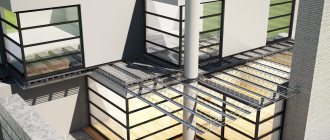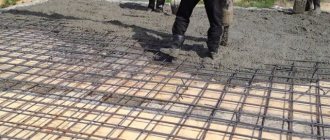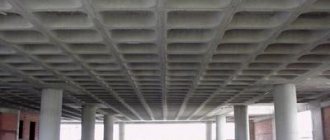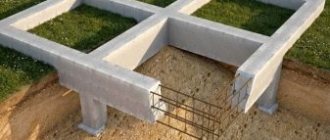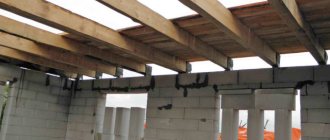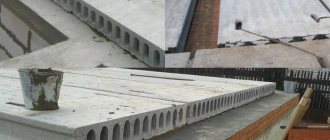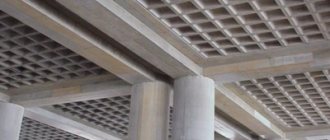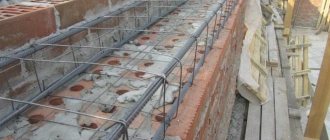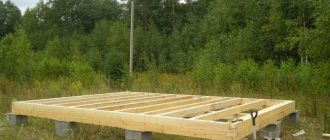Monolithic ones are one of the most reliable building surfaces.
Made using reinforcement and high grades of concrete, they have strength, density, frost resistance, resistance to mechanical and atmospheric influences, and can last for many decades.
Monolithic concrete floors are often used where lifting equipment cannot travel to transport reinforced concrete slabs, and where horizontal structures (spans) for interfloor, attic, basement and staircase spaces are non-standard.
How monoliths are constructed, what are the regulatory requirements and technical characteristics for them, the creation process, advantages, reinforcement and other nuances, we suggest you learn from this article.
Description of solid structure
A monolithic floor is a slab of arbitrary dimensions, determined by the adopted design, and manufactured directly at the construction site. The monolith has a rectangular or square shape . It consists of a concrete composition poured onto reinforced strong rods of strong grade steel, laid and welded in the form of a mesh.
To obtain a monolith, a formwork form is installed on the marked area of the building, into which reinforcement is laid, and then the concrete mixture is poured and compacted on top, leaving it until it hardens (dries) completely.
The resulting floor slab must have a thickness of at least 8 (cm), according to standards 12-20 (cm), and rest on structural (load-bearing walls). The formwork to create a monolith is formed from wood, plywood, and auxiliary beams made of non-corroded metal. Sometimes racks are used for floors, and the reinforcement frame can be composed of a lower layer, as well as a supporting one.
The resulting horizontal structure
is suitable for all types of residential and industrial buildings .
The strength, rigidity and density of the surface evenly distributes the load. The monolith is immune to vibrations and mechanical stress, which makes it indispensable in seismically active regions. Concrete surfaces repel water well and are not self-igniting or fire hazardous. It is convenient to work with the monolith, and with the help of construction tools to arrange various communications. The types of cement used for concrete are M300, 400, 500, crushed stone, sand and water.
The thickness of the concrete floor is 200 (mm) using 12 (mm) rods welded together into a mesh with cells 200 x 200 (mm). The load standards that a monolithic surface can accept are 150 kg/m2.
Monolithic floors are considered necessary building elements in the construction of complex architectural structures, with special parameters and special configuration parameters. In addition, they are ideal for foundations, roofing and spans between floors.
Design diagram of the main beam (a) and envelope diagram of bending moments (b)
Ribbed floors with slabs operating in two directions also consist of slabs and monolithically connected supporting beams. The grid of beams can be equal to the grid of columns (Fig. below) or be significantly smaller (Fig. below). In the latter case, the ceiling is called coffered. The most common dimensions of the beam grid vary within 1.5-6 m. As a rule, the location of the supporting beams coincides with the direction of the axes of the column grid. For reasons of architectural expressiveness, the location of the beams can be diagonal with respect to the grid of columns.
Types and types of such reinforced concrete floors
There are several types of reinforced concrete structures. Each presented type has its own purpose, and its creation completely depends on the developed project. Varieties of monolithic floors are divided into the following groups.
According to the method of support
There are such varieties:
- 2 sides - on two opposite parallel load-bearing walls, capable of withstanding external loads of up to 800 kg/m2;
- 3 sides - with the help of end reinforcement they are laid on three structural walls, with a load rating of 1600 kg/m2;
- 4 sides are structures reinforced with reinforcement, which are used only for multi-story construction, and have the highest strength (cement M500, 700), with loads from 2400 kg/m2.
By establishment depth in mm
Types of floors according to the depth of the establishment:
- 40 – contour, 2 long, 1 short side;
- 50 – 2 sides, span up to 4.2 (m), 2 short, 1 long sides;
- 70 – 2 sides, with a span of more than 4.2 (m).
By typical features
There are the following types:
- ribbed - in cross section they resemble the letter “H”, have upper or lower ribs;
- beamless - solid structures that can rest on any side, depending on the project;
- beam - have auxiliary, main or intersecting beams, which are formed together with the ceiling, thanks to the special formwork shape.
There are also such types of monolithic slabs as:
- classic (full-bodied);
- caisson (for the basement foundation);
- Swedish (insulated with waterproofing);
- on a profiled sheet (using permanent formwork in the form of a profiled sheet);
- cup-shaped (regular or inverted).
The maximum support depth of a monolithic slab should not be more than 150 (mm).
Design diagram of the secondary beam (a) and envelope diagram of bending moments (b)
The loads on the main beam are considered to be applied in the form of concentrated forces from the weight of the secondary beams, slabs g and the live load P collected from the corresponding load areas. To simplify the calculation, the self-weight of the main beams also results in a concentrated load applied in the axes of the secondary beams. The design diagram of the main beam is also a continuous structure with design average spans taken equal to the distance between the axes of the supports (Fig. below, a). The location of the live load (across the span or in adjacent spans) is considered in several combinations in order to identify the maximum span and support bending moments in the section of the main beam (Fig. below, 6).
Regulatory Requirements
Important standards that relate to the creation, installation and operation of monoliths, establishing the class of concrete and the quality of reinforcement include the following technical documents :
GOST 13015-2012.- GOST 12767-94.
- GOST 9561-2016.
- GOST 34028-2016.
- GOST 25192-82.
- GOST 26434-2015.
- SNiP 3.03.01-87.
- SNiP 52-01-2003.
- SP 52-103-200.
- SP 387.1325800.2018.
- SP 371.1325800.2017.
- SP 63.13330.2012.
- SP 70.13330.2012.
The presented standards emphasize that the reinforcement and pouring of a monolith must always be documented in an Act called “Inspection of hidden work.”
The Act is always signed by the chief engineer of the facility and the foreman, under whose leadership the laying, binding, welding and formation of the metal frame of the concrete floor took place.
Here special attention is paid to deviations, which according to standards must be within the following limits :
- + 20 (mm) – for individual working rods;
- + 10 (mm) – for mesh rows;
- 15 (mm) – from the design thickness of the concrete layer, 5 (mm) to 200 (mm) thickness;
- 70% – and higher (strength of concrete mixture).
If the concrete composition has already been laid and compacted into the formwork, it is prohibited to add water to the composition to create mobility of the solution. The line of the monolith plane should not be deviated by more than 30 (mm), therefore, when marking and forming the formwork, pay attention to the accuracy of the distribution of the concrete mixture. For surface joints, a deviation of only 3-5 (mm) is permissible.
The resulting monolithic surfaces are divided into 4 main classes, which have certain dimensions and depend on the type of concrete, steel frame and the degree of complexity of their creation.
The finished monolith is not allowed to have:
- stains of rust and grease, except for class A7 floors;
- exposed areas of reinforcement and concrete seals, with the exception of specially left parts of the frame for further connection and welding;
- reinforcement not treated with anti-corrosion agents;
- the presence of cracks on the surface, chips and large shells from 4 to 20 (mm).
In addition to meeting standards, it is necessary to use only high-quality labeled materials in work. At the same time, manufacturers must provide certificates, guarantees and all necessary accompanying documentation for manufactured products.
To eliminate all irregularities and form a smooth monolithic surface, ready for finishing, it is allowed to grind it in any convenient way.
If in a construction project the floors are made curved, then the requirements for them are formalized in the documentation as separate paragraphs.
Characteristics and parameters
An important parameter of the monolith is its thickness , which should be at least 180-200 (mm). The thickness indicator is 1/30, as this indicates that its dimensions should be at least 30 (mm) per 1 (m) of flooring.
The greater the distance between the walls, the thicker the monolith should be. But for small expected loads they can be made 10-15% smaller.
In addition, the finished floor is created from non-combustible materials, and therefore must comply with the technical group “NG”. Also important technical characteristics include :
Strength – 390-400 kg/cm2.- Mobility P3-P4.
- The concrete grades used are from M400.
- Frost resistance – F
- The most common concrete class is B30.
- Hardness – Zh3-Zh4.
- Water resistance - group W12.
When constructing monoliths, all performance indicators are taken into account in the calculations, since projects are drawn up for structures of different types of complexity. Monoliths are reliable, can withstand heavy loads, and are well attached to load-bearing walls. The variety of filling options depends on the formwork shape . Due to its rigidity, the formation of cracks at the joints is eliminated.
The main feature of reinforced concrete floors is that they simultaneously serve as a ceiling on one side and a floor on the other.
You can read more about the characteristics of monolithic floors in this article.
Structural solutions
When choosing a monolithic floor design, you should focus not only on the properties and characteristics of the material used or the layout of the house being built. A slab made of monolithic concrete must withstand loads that must be taken into account and calculated.
Monolithic floors can be constructed in various ways:
- using beams;
- without beams;
- with a removable formwork device;
- on corrugated sheets.
For small residential buildings, the most acceptable option is to install prefabricated formwork.
Reinforced belt
Reinforced belts are often formed as the last layer of a structural wall, before creating roof slabs, as well as in multi-story buildings. This additional reinforcement - a reinforced concrete reinforcement belt - gives additional protection to load-bearing walls , which will protect them from cracks in the future, since the ceiling takes on part of the load-bearing load from the upper floors or roof.
The formed belt is somewhat reminiscent of a reinforced concrete beam with closed edges. Its elements are rods with a diameter of 12 (mm), laid and fastened in the form of a frame, as well as concrete poured over it. The additional purpose of a reinforced belt is especially recommended during the construction of buildings with subsiding soils or in an unfavorable climatic and seismically active zone, to reduce deformation on the walls of the building.
Also, reinforced belts help to connect the frame and foundation of a structure, level the horizontal planes of structural walls, and become a reliable basis for floors. Rods are laid and welded into wooden formwork, pre-installed around the perimeter, forming a continuous circular structure, and then ready-made concrete is poured.
The height of the structure must correspond to 30 (cm) . During the arrangement, precise measurements are taken and poured along the beacons and construction lacing. You can also use laser rangefinders in your work.
You can insulate a reinforced belt with ordinary polyurethane foam, using a special technology, when holes are made in the solution into which a foam composition is introduced. Additionally, the reinforced concrete belt can be covered, but only after the ceiling has been installed.
The reinforced belt takes more than 1 week to dry. It is best to install the floors after the composition has completely hardened.
Installation
Installation of foundation beams will not be possible without the participation of special equipment - a crane. To be engaged by a winch, the grand beam must be equipped with special loops or sling holes, which are made during its production. Installation can begin only after completion of the preparatory work, namely:
- Conducting geological studies of the soil to determine the composition of the soil.
- Calculation of the total building load
- Completion of work on the construction of a monolithic foundation. A solid foundation is formed by compacting the soil and filling it with sand or other heavy soil.
- Organization of delivery and storage. During this work, it is necessary to check each product for integrity and absence of damage.
- Carrying out quality control of all materials.
- Clearing the construction site of dirt, snow and debris.
- Carrying out marking of the future structure. Marking is done using pegs, between which a thread is stretched.
Therefore, it is necessary to use a building level in your work.
When performing installation work, it is important not to rush. The slightest mistakes can be costly
There are often cases when the mounting loops of beams break due to errors in operation. After such a cliff, if the foundation beam is on the ground, it will be almost impossible to lift it. In addition, due to the hasty actions of the crane operator, the beam may crack if it is touched or dropped. And in some cases it will even break if it is not reinforced.
During installation, the foundation beam must rest on a stepped structure of support pillars. The steps can be made of brick or cast from concrete using formwork. The contact area should not be less than 200–300 mm. Otherwise, it will be difficult to secure the beam, which will lead to the risk of its displacement. The final stage in the construction of fundamental beams will be the processing of their surface. In this work, it is necessary to use waterproofing materials, for example, roofing felt or waterproofing to ensure the safety of the walls.
Technology and pouring process
The rules for the formation of a monolithic concrete floor are determined by the current GOSTs and SNiPs. First of all, a project with calculations must be submitted, according to which the thickness and dimensions of the monolith, the type of reinforcement used, the grade of concrete and the formwork will be determined.
Prefabricated removable formwork, with horizontal and lateral surfaces, is installed and securely fastened along the finished reinforced belt, structural (load-bearing) walls and supporting supports (beams, racks, channels). Then the installation steps are as follows :
- Laying film or lubricating the mold with automotive oil.
- Structural reinforcement - laying rods or knitting mesh (+ welding), depending on the formation of the layer - with one layer of reinforcement, or with two, with end clamps of 400 mm pitch.
- Pouring the prepared concrete composition into the formwork without construction waste, with the formation of engineering holes along pre-marked paths. Filling must be done immediately to the end to prevent the formation of additional seams.
- Work with the composition and leave it until it dries and gains strength for several weeks.
To ensure that the solution is distributed evenly, it is leveled with a smoothing iron and a vibrator is used to better fill the mold. The solution for large surfaces is supplied to the site using a stationary concrete pump.
If the solution is prepared on site, then all the necessary components are mixed in an automatic concrete mixer. The best temperature for working with concrete is 12-25 °C.
The easiest way to measure the thickness of a monolith is with special construction probes. It is most convenient to use formwork with telescopic supports, as they are height adjustable.
All information about the construction and pouring of a monolithic floor is here.
Concreting a monolith - pouring a monolithic floor on your own
To ensure the strength and uniformity of the reinforced concrete surface, it is necessary to pour a monolithic floor slab in one step. Given the increased need for concrete, it is advisable to purchase a ready-made solution delivered in a construction mixer.
Filling the floors with your own hands is carried out according to the following algorithm:
- The concrete solution is fed into the formwork and distributed evenly over the entire area.
- Compaction is carried out using a deep or surface vibrator.
After compaction, the surface of the massif is leveled, hardening for four weeks.
What are thermal inserts?
Cold bridges can form between the ceilings, leading to heat loss in the building. Therefore, during the construction process, specialists use embedded elements with good thermal conductivity, which are called thermal liners.
The products are made from durable material such as Penoplex, which retains heat well. Together with the insulation applied to the finished monolith, they create a general outline.
The issue of thermal liners (layers of thermal insulation material) is resolved at the planning stage. A diagram of their laying between the connecting elements of the floor is drawn in advance.
Penoplex thermal liners are produced by manufacturers in three main size ranges :
- 150 x 150 x 200 (mm);
- 300 x 150 x 200 (mm);
- 600 x 150 x 200 (mm).
Products of any group have an ideal rectangular shape, and their advantages include:
- thermal conductivity index – 0.033 W/(mˑ°K);
- strength coefficient – 20 t/m2;
- resistance to water, fungi and mold;
- quick installation;
- environmental friendliness;
- resistance to external factors;
- durability (more than 60 years).
The products can be laid along the entire perimeter of the ceiling in private and multi-storey buildings. To do this, step back up to 100 (mm) from the edge, leaving a step for the thermal insert of 250 (mm). An important feature of insulating layers is that reinforcement can be laid directly into them . And concrete pouring is done on top of the reinforcement.
Thermal liners for monoliths can additionally provide good sound and heat insulation. You can work with them in any weather.
Strengthening concrete slabs
Many builders use additional reinforcement for monoliths. This manipulation consists of applying an additional layer of reinforced concrete composition to the surface. To do this, the ceiling is washed with water, cleaned and notched with a chisel. If there are exposed areas of reinforcement, they are cleaned of dust and rust. The depth of the notches is 0.5-1 (cm).
Strengthening concrete floor slabs helps not only to further strengthen the surface, but also to restore their integrity, improve technical characteristics and load-bearing capabilities.
Restoring integrity is necessary if there is:
- exposed reinforcement;
- visible wear - the presence of defects, cracks, detachments and screeds, etc.
In order to correctly perform reinforcement, it is imperative to carry out calculations based on the collected documentation, after a visual inspection and measurements of defects.
Metal channels, pipes, and beams with a large cross-section are used as reinforcing reinforcement for floors. The entire surface is covered using a reinforced mesh with cells of at least 150 x 150 (mm). If the mesh is made from rods, then their diameter should be 14-18 (mm).
Existing cracks and defects are repaired using one of the methods - shotcrete (applying concrete mortar from a special spray gun under a given pressure over the entire frame).
Causes of defects and cracks
Various shortcomings that may appear on a monolith are largely related to the quality of materials and non-compliance with technical installation standards when working with consumables.
It is best to purchase elements for a monolith (concrete mixture + metal reinforcement) from trusted manufacturers who are able to provide consumers with high-quality certified products.
The main defects of monolithic floors are considered to be:
Appearance of cracks. Poorly compacted and vibrated areas, inappropriate temperature for work, poor composition, which contains a lot of water and sand.- Exposing the reinforced parts of the frame base. The thickness of the monolith was insufficient; not enough solution was poured.
- Formation of voids and shells. Associated with the quality of pouring, irregularities in pouring and distribution of concrete along the formwork.
- Obvious presence of foreign inclusions. Occurs due to inaccurate proportions and the use of unscreened or unsuitable material.
- Incorrect placement of seams. The work was not carried out according to the plan, which is why the surface geometry became incorrect.
- Presence of uncompacted areas. During the pouring process, there were no stages of uniform creation of the ceiling.
All these disadvantages also occur when:
- unprepared soil base;
- lack of concrete proportions;
- using more sand and water than required;
- poor compaction and vibration distribution of the composition;
- failure to comply with the required floor thickness;
- overconsumption of concrete composition.
To prevent defects, you need to accurately follow the installation and preparation steps in accordance with the design documentation. The specialist identifies existing deficiencies after a thorough visual inspection and taking the necessary measurements.
All imperfections are removed by additional reinforcement of the concrete surface. To do this, a layer of concrete is placed on a reinforced mesh. If there are large cracks, they are additionally tightened with anchoring, over which a mortar is poured.
Advantages and disadvantages
Monolithic concrete floors, according to experts, have the following advantages :
- High load-bearing capacity and durability. The structures are resistant to seismic loads and can withstand any mechanical and vibration impact, including shock waves.
- Good density and strength, thanks to the included components having good adhesion to each other.
- Possibility of installation directly on site, with your own hands, in any desired span size, formed along structural walls or columns.
- The composition used is environmentally friendly, made from natural ingredients that are safe for human health.
- Creation of the required thickness of the concrete span, in accordance with the design, without loss of strength characteristics and the required surface rigidity, as well as prevention of exposure of reinforced parts.
- A sufficient level of fire safety and the impossibility of spontaneous combustion.
- There is no need for mandatory replacement of all load-bearing elements, as well as the use of bulky construction equipment.
disadvantages to concrete floors:
- Certain temperature conditions and a strictly allotted amount of time are required to perform work with concrete.
- The process is labor-intensive and costs are high, compared to the use of reinforced concrete floor slabs by 20%.
The advantages of concrete monolithic floors are much greater than the disadvantages, which makes it possible to achieve strong, reliable structures and safety for further operation.
Fast and accurate formation of a monolith, with guarantees, is possible for any legal construction company that has all the necessary tools, mechanisms and consumables for this.
Telescopic stands
Vertical timber supports can be replaced with telescopic racks. A formwork system using height-adjustable racks significantly saves formwork installation time. Telescopes are simple and easy to use.
This stand is based on a metal pipe that extends like a telescope in increments of 10-17 cm. The stand contains:
- outer and inner pipe;
- threaded element for tensioning;
- staples;
- thrust bearing
Telescopic racks are used to create formwork at a height of up to 5 m. Operating principle: first, the thrust bearing is firmly fixed, then the inner pipe is raised to the desired height and fixed. The larger the diameter of this kind of jack, the higher its load-bearing capacity.
The optimal solution for a small house is to rent a fully equipped telescopic formwork system. The landlord will always help you correctly calculate the need for all formwork elements.
The cost of materials for rent is usually determined by the floor area. For a small construction site not very far from the lessor, the cost per square meter of fully equipped telescopic formwork varies in the range of 10-15 rubles per day of rental. With a non-standard floor configuration, the developer may have to purchase additional materials for the flooring.
Important! The installation step of timber supports is 50 cm, telescopic posts can be located in increments of 1 meter. This small nuance gives a good economic effect when using “telescopes” - they require half as many.
In addition, when using timber, illiquid scraps will certainly be formed - metal racks are not damaged and do not lose value after dismantling.
Price
Construction services are regulated by construction companies according to price lists, which are attached to cooperation agreements, or are listed on official websites. However, during work seasons the price may vary significantly . Also, a changing and growing market sets its own prices for consumables and services.
To determine the cost, the region is also important - the cities of Moscow, St. Petersburg, as well as the northern regions, the price for the services provided is always higher than other subjects of the federation.
On average, the price for the work of craftsmen + consumables from them can be presented in the following table:
| Completed monolithic works | Unit | Price, rub.) |
| Installation of reinforcement (rods), binding (mesh) and welding of frames | m2 | 4 200 |
| Preparation of the base of the monolith, with marking, mixing the components of the solution, pouring along the laid reinforcement | m3 | 5 400 |
| Formation of concrete pillars under the base in formwork forms | m3 | 4 100 |
| Creation and installation of concrete lintels for floors | 1 PC. | 600 |
| Creation of floors and foundations for columns and architectural arches | m3 | 4 000 |
| Floors with a thickness of 200 mm in multi-storey buildings | m3 | 9 000 |
Construction companies often give discounts to their clients, and also offer on-site measurements, calculations and drafting services for free. It is also profitable to buy building materials from them, since they purchase them directly from manufacturers at wholesale prices, which are always lower than market prices.
The cost of a monolith depends on the area of its creation. Labor costs can be much higher than purchasing ready-made reinforced concrete slabs, but there are undeniable advantages of its operation.
More information about the cost of monolithic floors here.
How to pour a monolithic floor slab - technology for performing the work
After performing calculations and determining the parameters of the reinforced concrete slab, you should prepare building materials, as well as the necessary tools.
After the formwork is arranged, a reinforcement frame made of two meshes is installed in it
The technology for forming a solid reinforced concrete slab involves performing the following work:
- Production and installation of panel formwork.
- Assembly of the reinforcement frame.
- Preparation of concrete solution.
- Filling the formwork with concrete mixture.
Let us dwell on the features of each stage.

